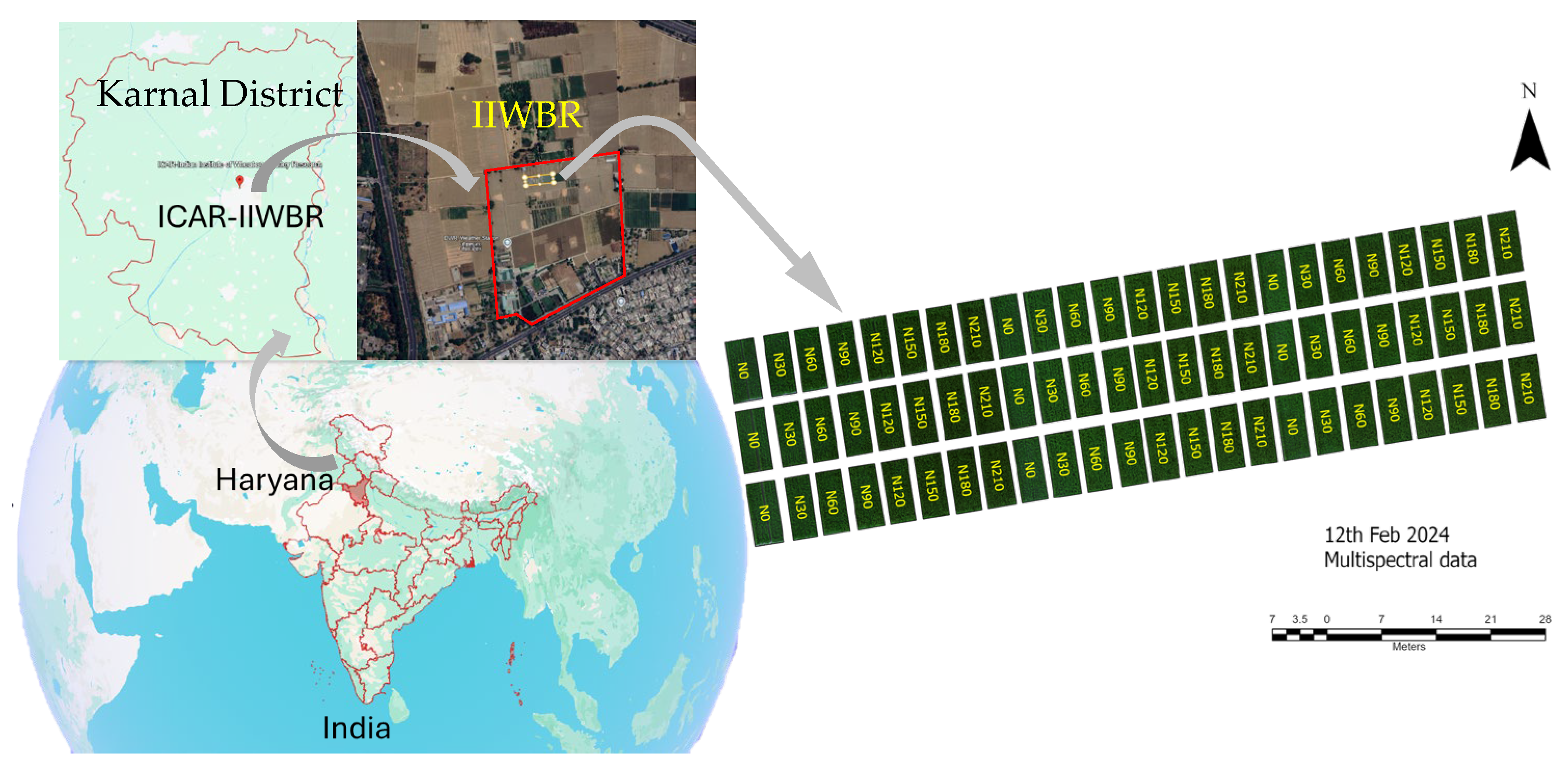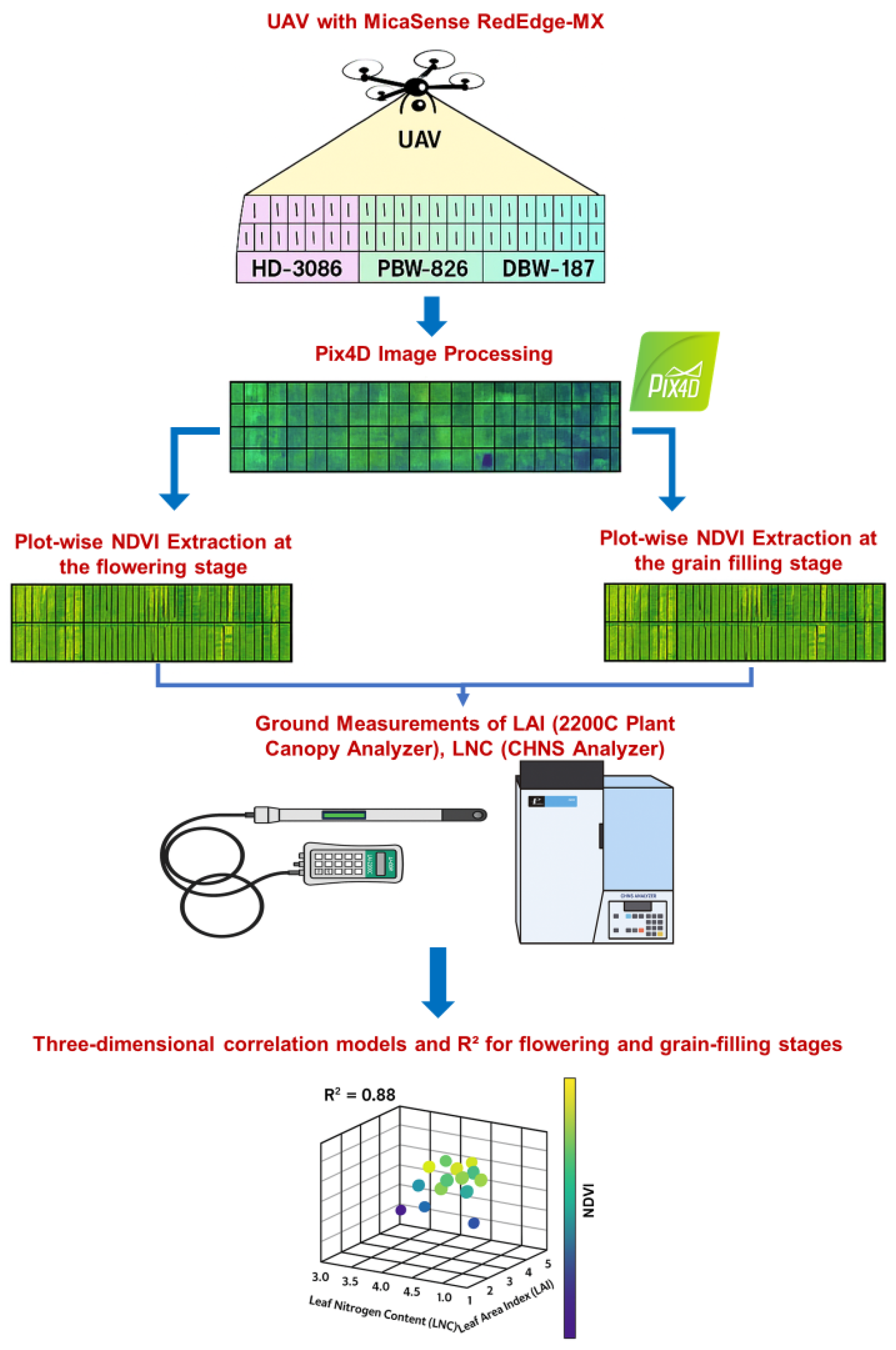Drone-Based Multispectral Imaging for Precision Monitoring of Crop Growth Variables †
Abstract
1. Introduction
2. Materials and Methods
2.1. Study Area and Experimental Design
2.2. UAV-Based Data Acquisition
2.3. Ground-Based Biophysical Measurements
3. Results
3.1. NDVI Analysis of Experimental Fields
3.2. Correlation Between NDVI and Biophysical Parameters
3.2.1. Relationship Between NDVI and LAI
3.2.2. Relationship Between NDVI and LNC
3.3. Varietal Differences
3.4. NDVI Correlations Across Growth Stages
3.5. Implications for Precision Agriculture
4. Discussion
5. Conclusions
Author Contributions
Funding
Institutional Review Board Statement
Informed Consent Statement
Data Availability Statement
Conflicts of Interest
References
- Fang, Y.; Sun, H.; Yan, Y.; Ren, J.; Dong, D.; Chen, Z.; Yue, H.; Durrani, T. Wheat Growth Assessment for Satellite Remote Sensing Enabled Precision Agriculture. In Proceedings of the 8th International Conference on Communications, Signal Processing, and Systems, Urumqi, China, 20–22 July 2019; Lecture Notes in Electrical Engineering. Springer: Singapore, 2020; Volume 571. [Google Scholar] [CrossRef]
- Choroś, T.; Oberski, T.; Kogut, T. UAV Imaging at RGB for Crop Condition Monitoring. In Proceedings of the XXIV ISPRS Congress, the International Archives of the Photogrammetry, Remote Sensing and Spatial Information Sciences—ISPRS Archives, Nice, France, 31 August–2 September 2020; Volume 43. [Google Scholar]
- Guebsi, R.; Mami, S.; Chokmani, K. Drones in Precision Agriculture: A Comprehensive Review of Applications, Technologies, and Challenges. Drones 2024, 8, 686. [Google Scholar] [CrossRef]
- Zhu, B.; Chen, S.; Xu, Z.; Ye, Y.; Han, C.; Lu, P.; Song, K. The Estimation of Maize Grain Protein Content and Yield by Assimilating LAI and LNA, Retrieved from Canopy Remote Sensing Data, into the DSSAT Model. Remote Sens. 2023, 15, 2576. [Google Scholar] [CrossRef]
- Fu, H.; Lu, J.; Chen, J.; Wang, W.; Cui, G.; She, W. Influence of Structure and Texture Feature on Retrieval of Ramie Leaf Area Index. Agronomy 2023, 13, 1690. [Google Scholar] [CrossRef]
- Su, X.; Nian, Y.; Yue, H.; Zhu, Y.; Li, J.; Wang, W.; Sheng, Y.; Ma, Q.; Liu, J.; Wang, W.; et al. Improving Wheat Leaf Nitrogen Concentration (LNC) Estimation across Multiple Growth Stages Using Feature Combination Indices (FCIs) from UAV Multispectral Imagery. Agronomy 2024, 14, 1052. [Google Scholar] [CrossRef]
- Fu, Z.; Jiang, J.; Gao, Y.; Krienke, B.; Wang, M.; Zhong, K.; Cao, Q.; Tian, Y.; Zhu, Y.; Cao, W.; et al. Wheat Growth Monitoring and Yield Estimation Based on Multi-Rotor Unmanned Aerial Vehicle. Remote Sens. 2020, 12, 508. [Google Scholar] [CrossRef]
- Zhang, J.; Cheng, T.; Shi, L.; Wang, W.; Niu, Z.; Guo, W.; Ma, X. Combining Spectral and Texture Features of UAV Hyperspectral Images for Leaf Nitrogen Content Monitoring in Winter Wheat. Int. J. Remote Sens. 2022, 43, 2335–2356. [Google Scholar] [CrossRef]
- Fu, Z.; Yu, S.; Zhang, J.; Xi, H.; Gao, Y.; Lu, R.; Zheng, H.; Zhu, Y.; Cao, W.; Liu, X. Combining UAV Multispectral Imagery and Ecological Factors to Estimate Leaf Nitrogen and Grain Protein Content of Wheat. Eur. J. Agron. 2022, 132, 126405. [Google Scholar] [CrossRef]
- Liao, Z.; Dai, Y.; Wang, H.; Ketterings, Q.M.; Lu, J.; Zhang, F.; Li, Z.; Fan, J. A Double-Layer Model for Improving the Estimation of Wheat Canopy Nitrogen Content from Unmanned Aerial Vehicle Multispectral Imagery. J. Integr. Agric. 2023, 22, 2248–2270. [Google Scholar] [CrossRef]
- Zou, M.; Liu, Y.; Fu, M.; Li, C.; Zhou, Z.; Meng, H.; Xing, E.; Ren, Y. Combining Spectral and Texture Feature of UAV Image with Plant Height to Improve LAI Estimation of Winter Wheat at Jointing Stage. Front. Plant Sci. 2023, 14, 1272049. [Google Scholar] [CrossRef] [PubMed]
- Hassan, M.A.; Yang, M.; Rasheed, A.; Yang, G.; Reynolds, M.; Xia, X.; Xiao, Y.; He, Z. A Rapid Monitoring of NDVI across the Wheat Growth Cycle for Grain Yield Prediction Using a Multi-Spectral UAV Platform. Plant Sci. 2019, 282, 95–103. [Google Scholar] [CrossRef] [PubMed]
- Liu, K.; Choo-Foo, K.; Wen, G.; Schoenau, J.; Knight, J.D. Assessing Crop Productivity, Grain Quality, and Soil Labile Carbon and Nitrogen in Pea-Based Intercrops under Low Nitrogen Input. Can. J. Plant Sci. 2025, 105, 1–12. [Google Scholar] [CrossRef]
- Vadillo, J.M.; Campillo, C.; González, V.; Prieto, H. Assessing Nitrogen Fertilization in Processing Pepper: Critical Nitrogen Curve, Yield Response, and Crop Development. Horticulturae 2024, 10, 1141. [Google Scholar] [CrossRef]
- Kaur, R.; Singh, B.; Singh, M.; Thind, S.K. Hyperspectral Indices, Correlation and Regression Models for Estimating Growth Parameters of Wheat Genotypes. J. Indian Soc. Remote Sens. 2015, 43, 551–558. [Google Scholar] [CrossRef]
- Chen, J.; Wang, P.; Sun, W.; Ling, L. Directional Vegetation Index and Its Effects on Normalized-Difference-Vegetation-Index-Based Agricultural Applications. In Proceedings of the Geoinformatics 2006: GNSS and Integrated Geospatial Applications, Wuhan, China, 28–29 October 2006; Volume 6418. [Google Scholar]
- Tao, Y.; Xu, Y.; Ye, C.; Zhu, J.; Xiao, D.; Liao, W.; Zhu, Y.; Chu, G.; Xu, C.; Wang, D. Exogenous N Supply on N Transportation and Reuse during the Rice Grain-Filling Stage and Its Relationship with Leaf Color-Changing Parameters. Agronomy 2024, 14, 2321. [Google Scholar] [CrossRef]
- Lykhovyd, P.V.; Vozhehova, R.A.; Lavrenko, S.O.; Lavrenko, N.M. The Study on the Relationship between Normalized Difference Vegetation Index and Fractional Green Canopy Cover in Five Selected Crops. Sci. World J. 2022, 2022, 8479424. [Google Scholar] [CrossRef]
- Tenreiro, T.R.; García-Vila, M.; Gómez, J.A.; Jiménez-Berni, J.A.; Fereres, E. Using NDVI for the Assessment of Canopy Cover in Agricultural Crops within Modelling Research. Comput. Electron. Agric. 2021, 182, 106038. [Google Scholar] [CrossRef]




Disclaimer/Publisher’s Note: The statements, opinions and data contained in all publications are solely those of the individual author(s) and contributor(s) and not of MDPI and/or the editor(s). MDPI and/or the editor(s) disclaim responsibility for any injury to people or property resulting from any ideas, methods, instructions or products referred to in the content. |
© 2025 by the authors. Licensee MDPI, Basel, Switzerland. This article is an open access article distributed under the terms and conditions of the Creative Commons Attribution (CC BY) license (https://creativecommons.org/licenses/by/4.0/).
Share and Cite
Venkata Sai Chakradhar Reddy, D.; Sahoo, R.N.; Kondraju, T.; Rejith, R.G.; Ranjan, R.; Bhandari, A.; Moursy, A.; Tripathi, S.C.; Kumar, N. Drone-Based Multispectral Imaging for Precision Monitoring of Crop Growth Variables. Biol. Life Sci. Forum 2025, 41, 10. https://doi.org/10.3390/blsf2025041010
Venkata Sai Chakradhar Reddy D, Sahoo RN, Kondraju T, Rejith RG, Ranjan R, Bhandari A, Moursy A, Tripathi SC, Kumar N. Drone-Based Multispectral Imaging for Precision Monitoring of Crop Growth Variables. Biology and Life Sciences Forum. 2025; 41(1):10. https://doi.org/10.3390/blsf2025041010
Chicago/Turabian StyleVenkata Sai Chakradhar Reddy, Devanakonda, Rabi N. Sahoo, Tarun Kondraju, Rajan G. Rejith, Rajeev Ranjan, Amrita Bhandari, Ali Moursy, Subhash Chandra Tripathi, and Nitesh Kumar. 2025. "Drone-Based Multispectral Imaging for Precision Monitoring of Crop Growth Variables" Biology and Life Sciences Forum 41, no. 1: 10. https://doi.org/10.3390/blsf2025041010
APA StyleVenkata Sai Chakradhar Reddy, D., Sahoo, R. N., Kondraju, T., Rejith, R. G., Ranjan, R., Bhandari, A., Moursy, A., Tripathi, S. C., & Kumar, N. (2025). Drone-Based Multispectral Imaging for Precision Monitoring of Crop Growth Variables. Biology and Life Sciences Forum, 41(1), 10. https://doi.org/10.3390/blsf2025041010







